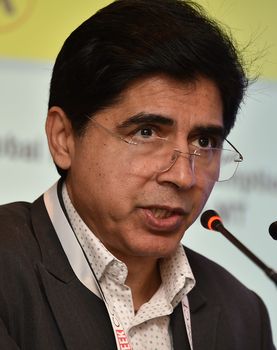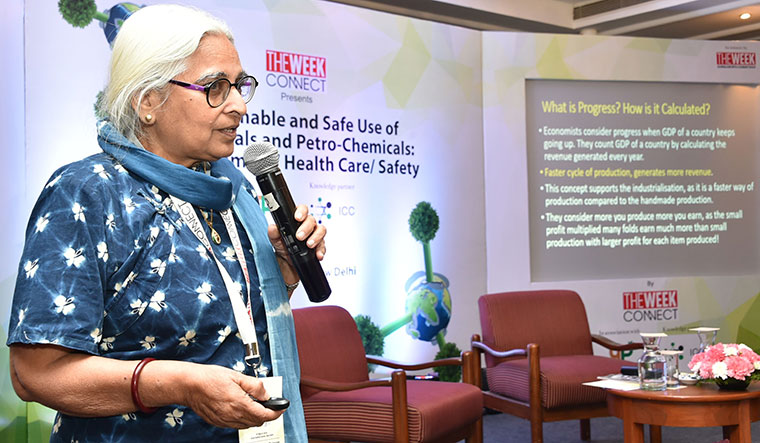PLASTIC POLLUTION is visible; it hits the eye, unlike greenhouse gases. This is, in a way, a good thing, because it impels people to do something about it. Thus, there could be immense economic and innovation opportunities in tackling plastic pollution. This was the positive takeaway from a day-long symposium on ‘Sustainable and Safe Use of Chemicals and Petrochemicals: Environment/Health Care/Safety’, conducted by THE WEEK CONNECT at the India Habitat Centre in New Delhi on March 6.
Both the keynote speakers, P. Raghavendra Rao, secretary (chemicals and petrochemicals), and C.K. Mishra, secretary, ministry of environment, forest and climate change, noted that the chemical and synthetic polymer industries would continue to grow, and their growth was actualy needed for the country’s development. Rao pointed out that India’s growth story was only beginning and in the next ten years, half the population would be living in urban areas. With poverty rates fast declining, consumption rates would rise rapidly. Mishra gave statistical proof of this. He said that the Swachch Bharat Abhiyan alone would require 280 metric tonnes of polymers over the next five years. As agriculture gets more dependent on drip and sprinkler irrigation, needs in this sector will rise exponentially, given that at present only ten per cent of suitable area is irrigated this way. “Plastic is an incredibly versatile material. We cannot live without it now. It has replaced glass and paper, increased the shelf life of products. It saves energy, water and even carbon,” said Mishra.
The buzzword at the symposium was circular economy, a concept wherein waste products of an industry can be monetised. Ravi Kapoor, former president of the Indian Chemicals Council, said this was a way in which the industry could grow and, at the same time, pay attention to the health of the environment. Growth rates are a cause for worry, emphasised S.K. Ray of the Indian Centre for Plastics in the Environment. He said that in the last 50 years, while the consumption of paper had increased eightfold, the consumption of plastics worldwide had increased several hundred fold, from 1.5 million tonnes to 350 million tonnes. “By 2050, they say, there will be more plastic in the oceans than fish,” he said, adding that measures like saying no to plastic straws would only tackle a percent of the waste problem. There was need for more involved solutions.
India has a good record with recycling. Of the 9.4 million tonnes of plastic waste generated every year in India, 60 per cent is recycled. While this is a much better score than Europe (30 per cent), China (22 percent) and the US (9.5 per cent), India still grapples with 3.4 million tonnes of plastic waste that remain un-recycled. Moreover, the quality of recycled plastic is inferior, and not suitable for industries like food processing or toys. Mishra said that there was technology available for good quality recycling; it just needed to be given a shot in the arm.
Speakers said that while there was opportunity for immense innovation, the industry was also bogged down with poor understanding of what the issues were. S.K. Jain of the Central Institute of Plastics Technology cited the example of state governments that were banning single-use plastic bags as knee-jerk reactions. “What is single use and what is not? These guidelines need clarity,” he said. “I feel that many items which are rated single use can actually be used multiple times.” He gave the example of the use-and-throw plastic cups. “They can be used more than once, can’t they?”
On the other hand, Supreme Court advocate Reena N. Singh noted how vested interests can obstruct viable recycling options. She spoke about the low-cost technology of using waste polythene and plastic to pave bitumen roads. Not only did this bring down the cost of road paving majorly, but it also ensured a 15-year life for that road. “This means the road does not have to be paved every second year. That means a loss for the road builder lobby, and so, they have been obstructing the technology vehemently,” she said.
Nikhil Deshpande, however, said that millennials would, over the next few years, drive innovation in finding solutions to the plastic waste issue. Deshpande, who heads Reliance Industries’ Sustainable Solutions and Climate Change vertical, said that the industry itself was taking the initiative. From companies like IKEA, which has committed to using only recyclable materials by 2030, to FMCGs investing in technology to develop virgin grade monomers from recycled plastic, there is a thrust from the industry itself to improve recycling economics. He spoke of an industry-led Alliance to Eliminate Plastic Waste, which was formed this January. The goal, he said, of a circular economy should be to ensure that scant little waste reached the landfills.
Blue’s due
In a room where everyone was deliberating about the opportunities and problems of synthetic fibres and dyes, Padmini Tolat Balaram, professor, Visva Bharati, Santiniketan, made a pitch for the forgotten dye—indigo. She spoke about how indigo remained a viable alternative to synthetic dyes, and by encouraging its cultivation all over again, it could be used far beyond dyeing textiles. Balaram’s presentation struck a chord with the audience, who agreed that the need and growth of the synthetic industry notwithstanding, there was need to go back to nature and come up with solutions and alternatives.





